If you are interested in a budget trip to China and would love to see the Chengdu pandas and visit the mysterious Tibet, have a close look below. Your tour will begin from the capital of China, Beijing. Besides the must-visit tourist attractions, your guide will also give you some suggestions to do some cheap shopping in Beijing. You might get an LV bag with about 20 dollars in markets like the Silk Street Market. After your Beijing tour, you will visit Chengdu. Chengdu has the world-famous panda breeding bases, and with us, you will visit the most popular one, the Chengdu Research Base of Giant Panda Breeding. Finally, you will have a budget Tibet tour. Many people would add “visit Tibet” to their bucket list. Tibet is a mysterious place even for us Chinese. And if you happen to be a Tibetan Buddhism lover, this would be even greater for you because you will see all sorts of monasteries there.

Our guide in Beijing will be holding your name sign and wait for you at the arrival hall of the airport and then transfer you to your designated hotel. Please kindly note that all types of transfers will be available, from standard types like Volkswagen to Mercedes Benz or even higher standards. And VIP airport pick-up service is also available upon request.
Today your guide will take you to the landmarks of Beijing, Tian’anmen Square, Forbidden City, Summer Palace. You will first be taken to Tian’anmen Square. It is the largest city center squares in the world. This is where the flag-raising ceremony takes place every day.
Then we will walk across the square and enter your next destination, the Forbidden City (closed each Monday). The Forbidden City is also known as the Palace Museum. The Palace Museum is the name what you will hear from the broadcast on the subway. You can tell from the name that this place used to be a palace and now a museum. It used to be the royal palace of 24 emperors and their families in the Ming (1368-1644) and Qing (1636-1912) Dynasties. The Forbidden City is closed every Monday except for public holidays like Labor Day Holiday and the Chinese New Year…
After you visit the Forbidden City, we will take you to Jingshan Park. Jingshan Park used to be the highest land in the city center of Beijing in ancient times. But the time has long gone as you can see that the skyscrapers in Beijing are rising fast. Anyway, you can take a few pictures of the Forbidden City at the Wanchun Pavilion of Jingshan Park, since it’s the highest spot in Jingshan Park and the panoramic view of the Forbidden City can be shot here.
After we get out of Jingshan Park, you will have some time to have lunch, lunch is not included in our program, but our guide will be happy to provide some suggestions! After your lunch, you will be taken to the Summer Palace. The Summer Palace is not in the city center because it used to be the Summer Resort of the royal families, and as the resort goes, it has to be far away from the hustle and bustle of the city. It will take about 1 hour to drive there from the center of Beijing. After your visit here, our guide will take you back to your hotel. Or he/she can drop you off at Wangfujing Street for you to do some shopping! After your time at Wangfujing, you will have to transfer back to your hotel on your own.
Optional tours/activities in the evening:
1. If you are looking for a nice show to watch, the Kungfu Show in the Red Theatre is a great choice for you. “The Legend of Kungfu” in the Red Theatre has been on for years and receives a good reputation among the audience. Normally the show starts at 19:00 every day. But during peak travel seasons, there will be two performances each night, one at 17:30, the other at 19:00. Duration of the show is 60-70 minutes.
2. If you would like to experience the nightlife in Beijing, your guide will take you to the Houhai bar area or the Sanlitun area. There are mostly bars in the Houhai area while you can find many clubs in the Sanlitun area.

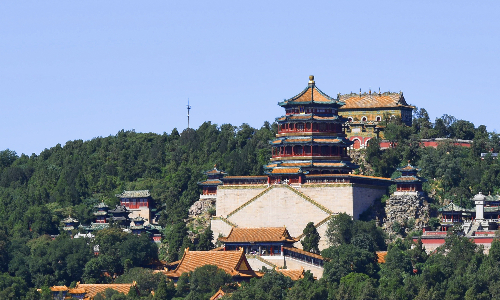
Make sure you have a nice and full breakfast at your hotel because we are going to take you to the Mutianyu Great Wall and you will do some hiking there. The Mutianyu Great Wall is the longest part of the Great Wall system in Beijing and throughout the country. It is 5,400 meters long and with 2,250 meters open to the public. The Great Wall is known as the longest defensive project in the world. There are a few sections of the Great Wall in Beijing like the Mutianyu, Badaling, Juyongguan, Jinshanling, Simatai. Comparing all the sections, the Mutianyu Part is less crowded, closer to the city center, better preserved, and more majestic. After your visit to Mutianyu, we will find somewhere for you to have lunch. Lunch is not included in our package price, but our guide will be happy to provide suggestions.
Then we will transfer back to the city center and you will pass by the National Stadium and National Aquatics Center in the Olympic Village. They are more widely known as the Bird’s Nest and Water Cube. We will stop at a spot where you can take pictures of these buildings. Afterward, you will be taken back to your hotel and have a nice rest!
Optional dinner:
If you would like to taste the famous Peking Roast Duck, we can take you to a nice local restaurant for it. The Peking Roast Duck was first introduced as a royal dish and has been a household dish since the Ming Dynasty. It is usually served in slices together with thin pancakes and sauces.


 Chengdu
Chengdu Before you travel to Chengdu, we will take you to the Temple of Heaven. The Temple of Heaven is the place where the emperors of the Ming and Qing Dynasties worship the god of heaven and offer sacrifices to them for praying for a good harvest in the next year. Now it has become a popular park for the locals to do morning exercises. After your visit to the Temple of Heaven, we will take you to the airport for your flight to Chengdu. Your estimated flight is MU6645 16:45/19:25. Upon your arrival in Chengdu, your guide will take you to your hotel there.
If you would like to do some last-minute shopping in Beijing, we can replace the tour to the Temple of Heaven with the Silk Street Market. This is an internationally famous shopping place for travelers that wants to buy all sorts of souvenirs. You will find things like silk products, pearls, Chinese traditional style clothes, Chinese fans, and handicrafts. You can even tailor-make your silk clothes there, but tailor-making clothes will take about 3 days or so, thus it would be more fitting for those that stay long enough in Beijing. Most of the vendors in the market can speak some English so don’t worry about communicating. And most importantly, remember to bargain!

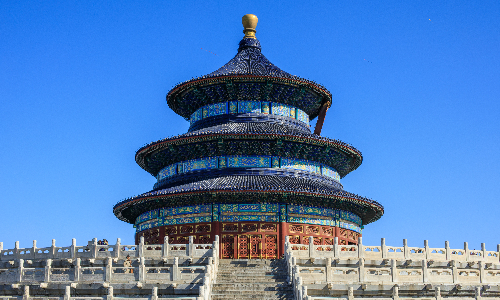
The first place your guide will take you to is the Chengdu Research Base of Giant Panda Breeding. There are about 200 pandas in the research base. If you are going to the base by yourself, you’d better go there in the morning so that you can have a better chance to see lively pandas as they prefer cooler weather. One kind reminder is that when you are taking pictures with your cellphone or camera, don’t use the flashlight, because it may hurt the panda’s eyes. Pandas are sensitive to light, especially the panda cubs.
Then you will visit the Wenshu Temple. The Wenshu Temple was founded in the Sui Dynasty (581-618). It is a famous Buddhist temple in western Sichuan and houses many precious relics and tens of thousands of Buddhist scriptures and documents. There are more than 300 Buddha statues in the temple.
Our last stop for today will be Kuan Zhai Alley. The Kuan Zhai Alley is also called Wide and Narrow Alley. It is a hot spot for both locals and tourists. Although Kuan Zhai Alley has gone through vicissitudes, it is a well-preserved Manchu relic in Chengdu. After renovation, as well as after certain netizens’ live broadcast, Kuan Zhai Alley in Chengdu quickly went popular. You will have some free time to stroll around the alleys and then you will be taken back to your hotel to have a nice rest! Or if you wish to stay longer here, you can then transfer back to the hotel on your own.

 Lhasa
Lhasa Today you will take the estimated flight MU2335 11:40/15:20 to Lhasa. Your guide will be waiting for you with your name sign and then take you to your hotel. On the way to your hotel in the city, we will pass by the longest river in Lhasa, the Yarlong Tsangpo River. The rest of the day is yours. Have some rest and adjust to the high altitude.
Here is something about the Tibetan culture that you might want to know. Tibetans are very particular about etiquette and have different ways of bowing to elders and peers when they see them. When they see elders or respectable people, they will take off their hat, bend down 45 degrees, and hold their hat in hand, close to the ground. When meeting a peer, they will usually take a slight bow and hold their hat in front of their chest. At this point, the bowing is only a courtesy. In some areas, a clasp of one’s hands and a bow are often done simultaneously. The clasped hands should be over the head to show respect. This way of saluting is also mostly used when meeting elders or respectable people.
Hada is the highest standard of Tibetan hospitality ritual. It expresses a warm welcome and sincere respect to guests. Hada is from the Tibetan language, and it means gauze kerchief or silk scarf. The color of Hada is mainly white, but there are also light blue or yellow ones. They are generally about 1.5 meters to 2 meters long, about 20 cm wide. The most precious type is with five colors: blue, yellow, white, green, red. The five-color Hada is used for the highest and most solemn ceremonies such as Buddhist rituals.
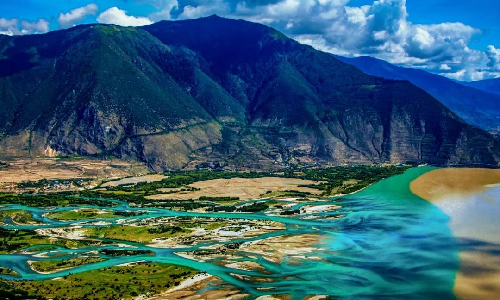
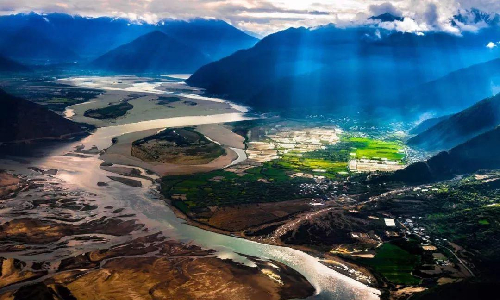
Your guide will first take you to the most famous tourist attraction in Lhasa, the Potala Palace. The Potala Palace is located at an altitude of 3,700 meters on the Red Mountain in the center of Lhasa. It is currently the highest and most majestic temple in the world. The palace has a huge collection of pagodas, statues, murals, thangkas, and scriptures. The most notable ones are the eight spiritual pagodas of five Dalai Lamas.
Afterward, we will take you to the Jokhang Temple. With a history of more than 1,300 years, Jokhang Temple has a supreme status in Tibetan Buddhism. It is the oldest surviving building of the Tubo period (633-842) and the earliest earthen structure in Tibet.
Afterward, we will head to Barkhor Street. The Barkhor Street surrounds the Jokhang Temple you just visited. Nearly all the houses on the street are shops selling Tibetan clothes, handicrafts, and goods from India, Nepal, and other countries. Many famous Lhasa restaurants are located here, such as Maggi Ami and Qiong Tian Teahouse. You will have some free time here and then your guide will take you back to your hotel.

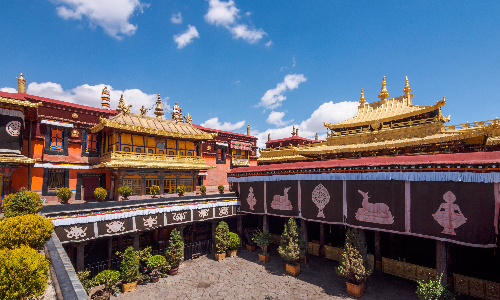
 Gyangtse
Gyangtse Shigatse
Shigatse Today you will spend a long time on the way. We will first drive you to Gyangtse and then Shigatse. Gyangtse is on the southwest of Lhasa, and it takes about 5 hours to drive there (about 260 kilometers). Going to Shigatse takes about 1.5 hours more of driving to the southwest (about 95 kilometers). Your first stop will be at Yamdro Yumtso Lake. It is regarded as one of the three divine lakes in Tibet together with the Mapon Yongtso, Namtso. Yamdro Yumtso means “a lake of jasper” in Tibetan. Devotees will take a lap around the lake to pilgrimage every year. The lap will take at least a month or so. If lucky, you might have a chance to see the devotees there.
Then we will pass the Karola Glacier. Karora glacier is one of the three major glaciers of Tibet, and it is also one of the four sacred mountains of Tibet. The place we admire the glacier has an altitude of 5,400 meters. The Karola Glacier is the shooting place of many films like the Red River Valley and The Knot.
Next, you will go to the Pelkor Monastery. It is also named Palcho Monastery or Palkhor Monastery. Pelkor Monastery was built more than 500 years ago. The monastery is constantly being renovated and diligently maintained to make this typical Tibetan Buddhist monastery building look like it’s still new. Then you will continue your journey to Shigatse. You will be taken to your hotel there and have a nice rest!

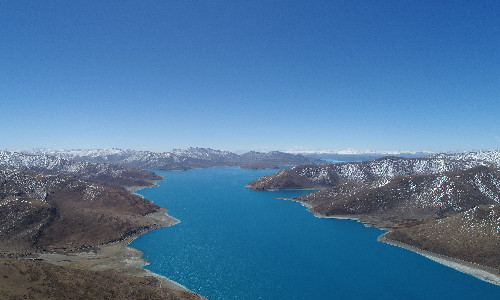
 Dingri
Dingri After your breakfast today, your guide will take you to the Tashilunpo Monastery. The Tashilunpo Monastery covers an area of 150,000 square meters and is surrounded by walls. The walls meander along the mountains with a circumference of more than 3,000 meters. The temple has 57 sutras and 3,600 houses. The entire monastery is built on the slope with its back to the mountains, and the halls are dense and balanced, harmonious and symmetrical.
Then you will continue your visit to the Shalu Monastery. Shalu Monastery is one of the largest Buddhist temples in Tibet, and it is also the ancestral temple of the Shalu sect of Tibetan Buddhism. The main building of Shalu Monastery is three-story high, which includes a large sutra hall, a rotating cloister, and more than a dozen temples.
Then you will visit the Sakya Monastery. Sakya means "gray and white earth" in Tibetan. The Sakya Monastery got its name like this because there is a piece of gray-white rock on the waist of Benba Mountain where the monastery is seated. The rock is weathered like earth now but you can still tell the color difference. After your visit to the Sakya Monastery, you will be transferred to Dingri. On your way there, our driver will stop at Lhaste for you to stretch your legs. Then your guide will escort you directly to your hotel in Dingri. Dingri is about 240 kilometers away to the southwest of Shigatse. It takes about 4.5 hours to drive there.
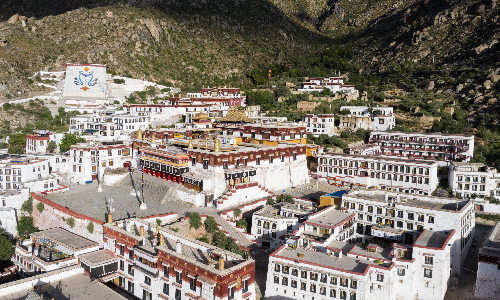
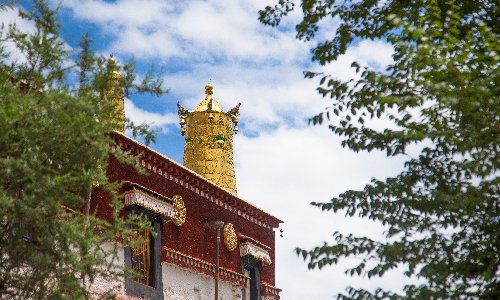
 Shigatse
Shigatse Today we will take you to have a look at the highest mountain in the world, Mount Everest. Mount Everest is also called Mount Qomolangma. It is a year-round snow-covered peak in the Himalayas on the border between China and Nepal. In the Tibetan language, Qomolangma means Mother Earth. According to the myth, Mount Everest is the place where the five goddesses of longevity lived. The Everest Base Camp is no longer available to tourists, at least for now it is not. It is because the environmental pollution is getting serious there due to large number of tourists. So, the local government currently forbids visitors from entering the base to allow some time for the recovering of the environment. So instead of the base camp, we will stop somewhere else for you to take some pictures and marvel at the magnificence of the mountain.
The place we will take you to is the Rongbuk Monastery. Rongbuk Monastery is located at the end of the Dzungpo Glacier at the northern foot of Mount Everest. It is 5,154 meters above sea level and about 20 kilometers from the summit of Mount Everest. It is the perfect place to watch Mount Everest. After visiting the Rongbuk Monastery, your guide will take you back to Shigatse.


 Lhasa
Lhasa Today will also be your transfer day, we will have to go back to Lhasa to catch your flight home or to your next destination. Today you will start your journey after breakfast. It takes about 5 hours (about 270 kilometers) on the way from Shigatse to Lhasa. You will have a chance to visit a local Tibetan family on your way. You can get a deeper insight into the locals’ lives and their culture. Your guide and driver will escort you to your hotel in Lhasa upon your arrival.
It’s time to say goodbye to your China tour today! Your driver and guide will pick you up from your hotel and take you to the airport according to your flight time. Hope you have enjoyed traveling with us!
Editor: Liz Lee
Proofreader: Summer Hou
| City | Five Star hotel list | Four Star hotel list |
|---|---|---|
| Beijing | Sunworld Dynasty Hotel Beijing Wangfujing | Sunworld Hotel Wangfujing |
| Chengdu | Sofitel Chengdu Taihe | Holiday Inn Express Chengdu Jinniu |
| Lhasa | Shangri-La Hotel, Lhasa | Thangka hotel |
 |
![]() About your child or infant, please contact us for a discounted price.
About your child or infant, please contact us for a discounted price.



We started with a few days in Beijing & ended in Shanghai, from where we visited the Forbidden City and Great Wall. In between we visited Terra Cotta Warriors Museum, Panda Base, Shanghai Disneyland.

We had a wonderful holiday in China which will remain long in the memory. China is a breathtakingly beautiful country full of splendid temples and palaces, mountains and rivers, peaceful rural scenes and bustling shopping streets.
 QUICK ENQUIRY
QUICK ENQUIRY